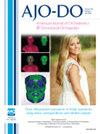Microcomputed tomography assessment of microleakage and void formation under ceramic adhesive precoated orthodontic brackets
IF 3
2区 医学
Q1 DENTISTRY, ORAL SURGERY & MEDICINE
American Journal of Orthodontics and Dentofacial Orthopedics
Pub Date : 2025-02-01
DOI:10.1016/j.ajodo.2024.09.013
引用次数: 0
Abstract
Introduction
This study aimed to evaluate microleakage, voids, and gaps in ceramic adhesive precoated (APC) brackets using microcomputed tomography and investigate their correlation with bond strength.
Methods
A total of 52 human premolars were included in this study. The teeth were randomly divided into 4 groups of 13 teeth each. The brackets used in this study were the Clarity Advanced APC Flash-free Ceramic Bracket (3M Unitek, Monrovia, Calif) and the Clarity Advanced Ceramic Bracket (3M Unitek, Monrovia, Calif). The materials used for each group were as follows: (1) 37% phosphoric acid, Transbond XT primer (3M Unitek, Monrovia, Calif), and APC Flash-free Ceramic Bracket; (2) Transbond Plus self-etching primer and APC Flash-free Ceramic Bracket; (3) 37% phosphoric acid, Transbond XT primer, Transbond XT light-cure adhesive, and Clarity Advanced Ceramic Bracket; and (4) Transbond Plus self-etching primer, Transbond XT light-cure adhesive, and Clarity Advanced Ceramic Bracket. The teeth were scanned using microcomputed tomography for microleakage, void, and gap analyses. The bond strength was measured and recorded in megapascals. One-way analysis of variance was used to compare parameters with a normal distribution. The Kruskal-Wallis test was used to compare parameters that did not comply with the normal distribution. The relationships among variables were evaluated using Spearman and Pearson correlation coefficients.
Results
There were no statistically significant differences among the groups in terms of gap volume, void volume, and total void and gap volume values (P >0.05). No significant differences were observed in relation to bond strength (P >0.05). The mean bond strength was 20.42, 19.87, 19.28, and 19.47 for groups 1-4, respectively. The Spearman’s correlation analysis results demonstrated that the bond strength was significantly affected by the gap volume and total void and gap volumes. The bond strength increased with reduced total volume of voids and gaps.
Conclusions
There was no difference between the APC Flash-free Ceramic Bracket and the Clarity Advance Ceramic Bracket regarding bond strength, void volume, gap volume, and total void and gap volume. The gap volume and total void and gap volumes significantly affected the bond strength. The bond strength increased with decreased total void and gap volumes. The bond strengths of the APC Flash-free Ceramic Brackets were comparable to those of the ceramic brackets bonded using the conventional method.
微计算机断层扫描评估陶瓷粘合剂预涂正畸托槽下的微渗漏和空隙形成。
简介:本研究旨在利用微计算机断层扫描评估陶瓷粘合剂预涂(APC)托槽的微渗漏、空隙和间隙,并研究其与粘合强度的相关性:本研究旨在利用微计算机断层扫描评估陶瓷粘合剂预涂(APC)托槽的微渗漏、空隙和间隙,并研究它们与粘接强度的相关性:本研究共纳入 52 颗人类前臼齿。这些牙齿被随机分为 4 组,每组 13 颗牙齿。研究中使用的托槽是 Clarity Advanced APC 无闪陶瓷托槽(3M Unitek,加州蒙罗维亚)和 Clarity Advanced 陶瓷托槽(3M Unitek,加州蒙罗维亚)。每组使用的材料如下:(1) 37% 磷酸、Transbond XT 底漆(3M Unitek,加州蒙罗维亚)和 APC 无闪陶瓷牙套;(2) Transbond Plus 自酸洗底漆和 APC 无闪陶瓷牙套;(3) 37% 磷酸、Transbond XT 底漆、Transbond XT 光固化粘合剂和 Clarity 高级陶瓷牙套;以及 (4) Transbond Plus 自酸洗底漆、Transbond XT 光固化粘合剂和 Clarity 高级陶瓷牙套。使用微型计算机断层扫描对牙齿进行扫描,以分析微渗漏、空隙和间隙。测量并记录粘接强度,单位为兆帕。采用单因素方差分析比较正态分布参数。Kruskal-Wallis 检验用于比较不符合正态分布的参数。使用 Spearman 和 Pearson 相关系数评估变量之间的关系:各组在间隙容积、空隙容积、总空隙容积和间隙容积值方面没有明显的统计学差异(P>0.05)。在粘接强度方面也没有观察到明显差异(P>0.05)。1-4 组的平均粘接强度分别为 20.42、19.87、19.28 和 19.47。斯皮尔曼相关分析结果表明,粘接强度受间隙体积、总空隙和间隙体积的显著影响。结论:结论:APC 无闪陶瓷牙套和 Clarity Advance 陶瓷牙套在粘接强度、空隙体积、间隙体积以及空隙和间隙总体积方面没有差异。间隙体积以及总空隙和间隙体积对粘接强度有显著影响。粘接强度随着总空隙和间隙体积的减少而增加。APC 无闪陶瓷托架的粘接强度与使用传统方法粘接的陶瓷托架相当。
本文章由计算机程序翻译,如有差异,请以英文原文为准。
求助全文
约1分钟内获得全文
求助全文
来源期刊
CiteScore
4.80
自引率
13.30%
发文量
432
审稿时长
66 days
期刊介绍:
Published for more than 100 years, the American Journal of Orthodontics and Dentofacial Orthopedics remains the leading orthodontic resource. It is the official publication of the American Association of Orthodontists, its constituent societies, the American Board of Orthodontics, and the College of Diplomates of the American Board of Orthodontics. Each month its readers have access to original peer-reviewed articles that examine all phases of orthodontic treatment. Illustrated throughout, the publication includes tables, color photographs, and statistical data. Coverage includes successful diagnostic procedures, imaging techniques, bracket and archwire materials, extraction and impaction concerns, orthognathic surgery, TMJ disorders, removable appliances, and adult therapy.

 求助内容:
求助内容: 应助结果提醒方式:
应助结果提醒方式:


